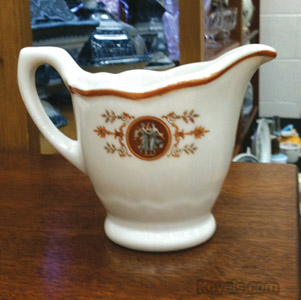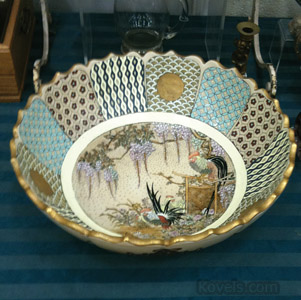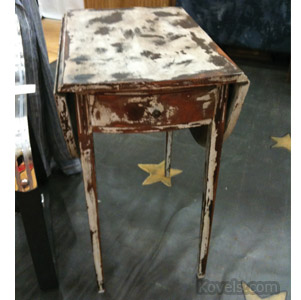There were many booths filled with fine formal antiques. A foot-high marble obelisk was $465. A pair of odd curvy Mason’s Ironstone plates picturing Chinese courtyard scenes was $600. The label said they were dessert plates, but I have a similar plate and unless it’s used to serve something as small as candy, it wouldn’t work. Willets Belleek demitasse cups and saucers, plain cream color with no decoration and an old mark, were $285 each. A spectacular Satsuma bowl (pictured), 18 inches in diameter, was priced $1,750. The quality of the decoration and the size made the price sensible.
Old sterling silver soup ladles seem to be a popular wedding gift. There were about a dozen priced from $350 to $495. One dealer was selling fairings, the little figurines originally sold at fairs in England; they were very popular a few years ago. Interest in them has waned, though. They were priced $300 to $400 and were genuine (many fakes have been made), but there were no takers. I see them at most shows for about $125 each. Today’s buyers are not interested in little figurines—old ones like fairings or newer Hummels and Florence Ceramic figurines.
Other poor sellers: no-name enameled ashtrays and bowls from the 1950s. Important artist-signed pieces attract high prices, but no-names sell for under $10. Costume jewelry cuff links sell for a bargain $5 each despite the fact that shirts made for cuff links are back in style.
A well-constructed period Pembroke table (pictured), game-table size, was only $195 but didn’t sell. That reflects the craziness of antique shows today. Brown furniture made before 1850 just doesn’t seem to sell. Chippendale desks, small cabinets, wing chairs and oak pedestal tables are all out of fashion. So they’re bargains right now. Of course, there was lots of white painted wicker for the porch and it all sold the first hour.
I always pick up “insider” stories at shows because the dealers know me. One dealer had a shelf filled with small creamers once used in railroad cars or hotels (a Syracuse China Corp. creamer is pictured). The creamers dated from the 1930s-70s and seem out of style now. A sign offered, “Your choice, $2 to $5.” The dealer said the creamers were from her sister’s long-time collection. She had 225 to sell and wanted someone to take all of them.
The dealer’s sister also has collections of butter pats and mustard pots. She bought everything at house sales, flea markets, shops and shows. She had a lot of fun, didn’t spend a lot of money and always found enough to make the search worthwhile. But now she figures it’s time to unload. No takers at this show for the collection, but the dealer sold about 10 singles.






Leave a Reply
You must be logged in to post a comment.